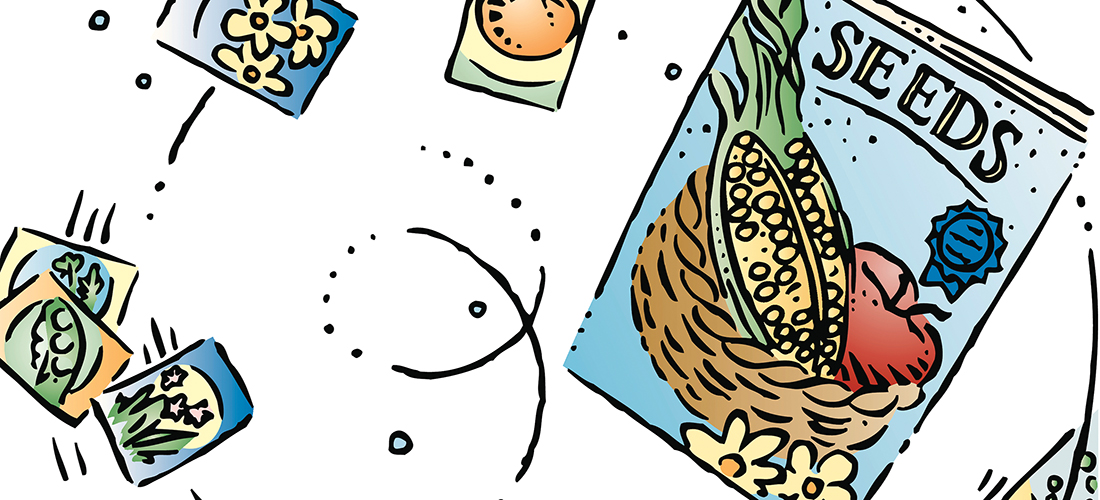
Cataloging Our Desires
A cornucopia of mid-winter reading
By Jan Leitschuh
You could call them Valentines from the fashion gardenistas.
Piled up by the couch, near the fireplace, lies a colorful pile of lavishly illustrated seed catalogs — the lurid romance novels of the produce patch. Tempters extraordinaire, as lovingly photographed as the sleekest supermodel, with their sexy photos of plump Chioggia beets, exotic red okra and butter-and-eggs sweet corn, these enticing, lush catalogs whisper breathily: Yes, darlin’, you, too, can grow produce like this.
Maybe.
Maybe not.
Years of hard practical experience in the Sandhills shoot back with cynical sweet nothings, like: Squash bugs. Blights. Thrips. Powdery mildew. Hornworms. Flea beetles. Weeds and 100-degree heat. Deer, bunnies and voles.
And yet, love is blind. The candy store that is a seed catalog is far too seductive when set against February’s stern, cold winds and deep-chill nights. We rationalize and justify — a few packets of seed, a valentine to ourselves.
In any case, we’ve been staring at these wish books, lovingly circling and then crossing off old favorites and tempting new varieties since Christmas. It’s time to order up — or pitch the damn things.
So, that gorgeous red okra. Do we want to try it this summer? For a couple of bucks, we can raise eye-catching scarlet pods. Then what? Will the hubby even eat red okra? The catalog listing swears it is the tenderest.
There’s an exotic orange variety from China as well. But maybe a Japanese pink okra would be an even more illicit garden thrill?
Flip to the “Garden Pea” section for the sugar snap selection. Garden lovers, take heed. If you only order one thing, from a catalog or a local provider, it ought to be a sugar snap pea variety.
Podded sugar snap peas come thick and fast at a time in the spring when fresh produce is deeply appreciated. The seeds can actually be planted directly in the garden pea patch this month. If you have grandchildren (or even if you don’t), picking these crisp, tender pods fresh, with their tiny, sweet peas inside, is gratifying. Children will eat them. Even more gratifying is tossing a fresh handful atop a salad, or into a soup, stew or dinner stir-fry.
Then that cynical voice of reason slides in a warning: deer. Deer love pea vines. (Note to self: Plant a few pots on the deck to climb up the porch rail, along with a patch in the garden. Closer to the kitchen, anyway.)
Eat Your Colors offers a rainbow of produce possibilities. All kinds of bright salad greens beckon from its catalog pages, as do multiple, colorful varieties of heirloom tomatoes. Black zucchini, magenta eggplant. The sweetest, most tender green beans. Candy cane-striped beets. Turquoise corn? Every possible color of sweet and hot pepper one can conjure (except turquoise).
The breathless, attendant copy makes each variety sound better than the last, the writers having cut their teeth on romance novels, no doubt. So many circled items, so little garden space . . .
But wait. What is this? The rabbit-hole distraction of the flower seed section. Silky purple poppies? Orange cactus zinnias? Stocks and snaps and strawflowers. That kiss-me-over-the-garden-gate — a pink, Victorian-era, cottage garden classic — looks intriguing. (Sound of pen circling.)
Hmmm, and here are gomphrena seeds . . . haven’t seen these sun-loving, hard-working little purple flower globes in local nurseries in a while . . . so maybe I should grow my own?
Many seeds can be sown directly into the garden or pots. Plus, a greater variety of seeds are available than the transplants you can find locally. Seeds are also less expensive than transplants.
You can also grow your own transplants, with a little desire. Six to eight weeks before the transplanting date, sow the seeds according to packet directions into some kind of a container indoors. They will need good light to stay stocky, and not grow leggy. Bottom heat also helps heat-lovers like peppers, eggplant and tomatoes.
Gradually transition your seedlings from the sheltered environment of your home to the garden. I like to set them out on sunny, mild days and bring them in at night before they chill. Toughen your tender love children by slowly introducing the transplants into full sun for a longer period each day, over a week’s time.
But back to our spring fever. The melons are particularly seductive. Perhaps try some small, serving-sized melons this year? Do we lust after the striking “copper red/striped with cream and green” 2-pounder from Punjab? The flesh is green and “slightly musky.” What does musky taste like?
Or would we rather plant that Armenian heirloom 1-pounder, a “vibrant yellow with fire-red zig-zag stripes,” with the “sweet, intoxicating aroma that will fill a room . . . ?”
No matter which sexy selection is chosen, and which fantasy fashionista seed ends up winging its way to our doors, it’s fair to say that we will remain true to our original garden valentine — the sugar snap pea. You really should try it if you haven’t, for fun.
Smile if ya got some. PS
Jan Leitschuh is a local gardener, avid eater of fresh produce and co-founder of Sandhills Farm to Table.





